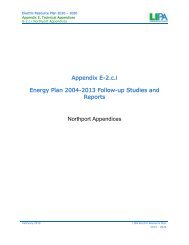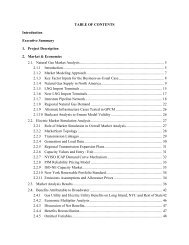Red Book - Long Island Power Authority
Red Book - Long Island Power Authority
Red Book - Long Island Power Authority
Create successful ePaper yourself
Turn your PDF publications into a flip-book with our unique Google optimized e-Paper software.
2012 Edition <strong>Red</strong>book<br />
2.0 DEFINITIONS<br />
Ampacity: The current, in amperes, that a conductor can carry continuously under the conditions of use<br />
without exceeding its temperature rating.<br />
Bonding - The permanent joining of metallic parts to form an electrically conductive path which will<br />
assure electrical continuity and the capacity to conduct safely any current likely to be imposed.<br />
Building: A structure which stands alone or which is separated from adjoining structures by fire walls<br />
with all openings therein protected by approved fire doors.<br />
Cable Systems: A cable system is the conduit and/or cable which is part of the service lateral.<br />
Company: <strong>Long</strong> <strong>Island</strong> <strong>Power</strong> <strong>Authority</strong> (LIPA)<br />
Cost or Expense: The cost of all materials, equipment, labor, and other definite charges plus a<br />
reasonable charge for other costs of a general nature (purchasing, engineering, etc.) involved in a<br />
project.<br />
Customer or Consumer: A person or any other entity who is approved for and supplied electric service<br />
by the <strong>Authority</strong>. Each Customer will have a unique account unless specified otherwise.<br />
Fire Wall: As per the Fire Marshall, a fire wall is considered a masonry wall at least 8 inches thick<br />
extending through all building stores and the roof, except where the roof is of fire resistant construction,<br />
in which case the masonry wall is carried up tightly against the lower side of the roof slabs. Acceptable<br />
construction includes concrete block, brick, and solid reinforced concrete. Any exception to this definition<br />
shall be certified in writing by a registered architect, licensed Professional Engineer, local Fire Marshall,<br />
or Building inspector stating that the wall meets the New York State Uniform Fire Prevention and<br />
Building Code. In addition, the letter must state that the wall meets the NEC requirement for an<br />
additional service to the building. Having a firewall does not entitle the customer to an additional<br />
service, but it is required for second service.<br />
Ground: A conducting connection between an electrical circuit or equipment and earth or some<br />
conducting body that serves in place of the earth.<br />
Ladder Accessible: Capable of being reached from the ground at level grade with an extension ladder.<br />
Line: A system of overhead poles, wires, and accessory equipment or underground ducts, conduits,<br />
and cables used for the distribution of electricity to Customers.<br />
Multiple Occupancy Building: A structure, including row houses, enclosed within exterior walls or fire<br />
walls, built, erected and framed or component structural parts, and designed to contain four or more<br />
individual dwelling units for permanent residential occupancy.<br />
Non-Residential Customer: A person, firm, or other entity, that does not use the service location as a<br />
residence.<br />
Point of Attachment: (POA) The overhead connection point mounted to the building owned and<br />
maintained by the customer to which LIPA attaches its service drop.<br />
Ring Out: A procedure used to verify that the meter and associated distribution panel have been<br />
correctly identified to avoid meter/billing problems.<br />
Self Contained Meter: A meter that contains the Current Transformers, "CT's" within the meter. The<br />
meter carries the entire customer load. Also known as "socket meters," Self Contained Meters are used<br />
on services up to 320 amps. See section 6 for special requirements at 277/480 volt.<br />
5






